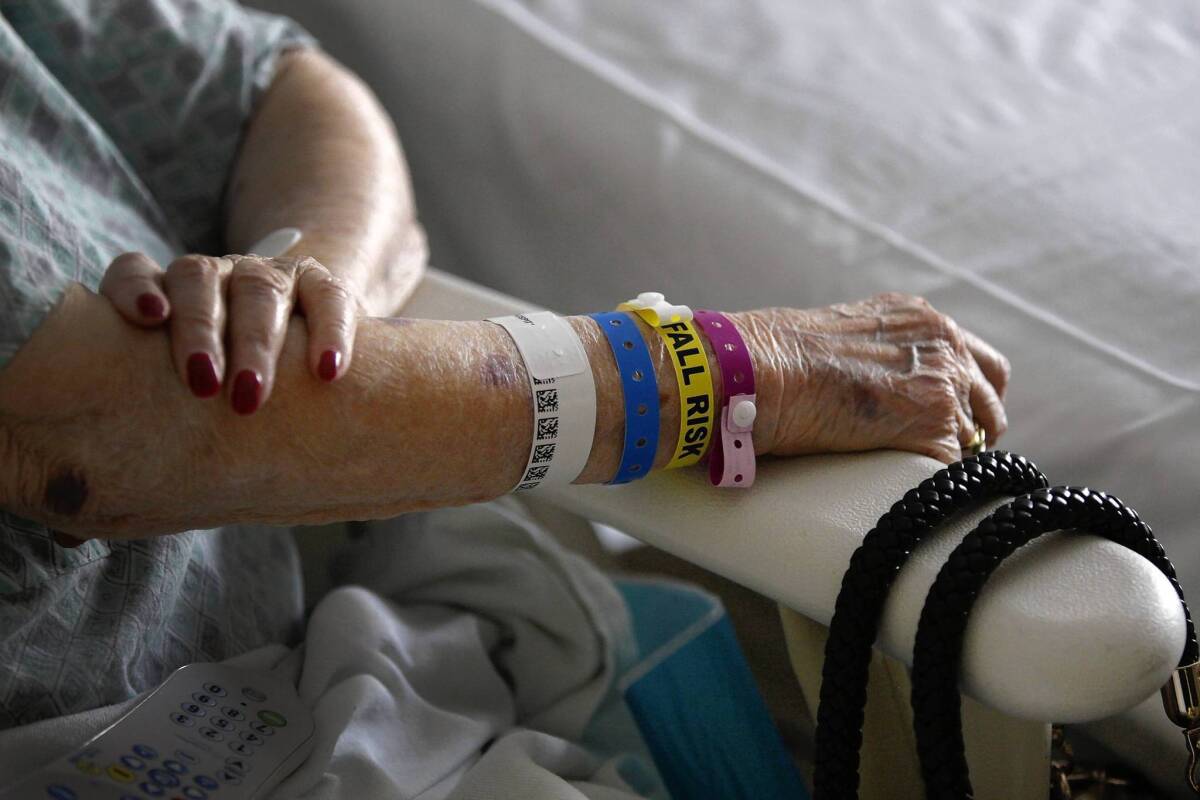A delicate new balancing act in senior healthcare

- Share via
When Claire Gordon arrived at Cedars-Sinai Medical Center, nurses knew she needed extra attention.
She was 96, had heart disease and a history of falls. Now she had pneumonia and the flu. A team of Cedars specialists converged on her case to ensure that a bad situation did not turn worse and that she didn’t end up with a lengthy, costly hospital stay.
Frail seniors like Gordon account for a disproportionate share of healthcare expenditures because they are frequently hospitalized and often land in intensive care units or are readmitted soon after being released. Now the federal health reform law is driving sweeping changes in how hospitals treat a rapidly growing number of elderly patients.
The U.S. population is aging quickly: People older than 65 are expected to make up nearly 20% of it by 2030. Linda P. Fried, dean of the Columbia University Mailman School of Public Health, said now is the time to train professionals and test efforts to improve care and lower healthcare costs for elderly patients.
“It’s incredibly important that we prepare for being in a society where there are a lot of older people,” she said. “We have to do this type of experiment right now.”
At Cedars-Sinai, where more than half the patients in the medical and surgical wards are 65 or older, one such effort is dubbed the “frailty project.” Within 24 hours, nurses assess elderly patients for their risk of complications such as falls, bed sores and delirium. Then a nurse, social worker, pharmacist and physician assess the most vulnerable patients and make an action plan to help them.
The Cedars project stands out nationally because medical professionals are working together to identify high-risk patients at the front end of their hospitalizations to prevent problems at the back end, said Herb Schultz, regional director of the U.S. Department of Health and Human Services.
“For seniors, it is better care, it is high-quality care and it is peace of mind,” he said.
The effort and others like it also have the potential to reduce healthcare costs by cutting preventable medical errors and readmissions, Schultz said. The federal law penalizes hospitals for both.
Gordon, an articulate woman with brightly painted fingernails and a sense of humor, arrived at Cedars-Sinai by ambulance on a Monday.
Soon, nurse Jacquelyn Maxton was at her bedside asking a series of questions to check for problems with sleep, diet and confusion. The answers led to Gordon’s designation as a frail patient. The next day, the project team huddled down the hall and addressed her risks one by one. Medical staff would treat the flu and pneumonia while at the same time addressing underlying health issues that could extend Gordon’s stay and slow her recovery, both in the hospital and after going home.
To reduce the chance of falls, nurses placed a yellow band on her wrist that read “fall risk” and ensured that she didn’t get up on her own. To prevent bed sores, they got her up and moving as often as possible. To cut down on confusion, they reminded Gordon frequently where she was and made sure she got uninterrupted sleep. Medical staff also stopped a few unnecessary medications that Gordon had been prescribed before her admission, including a heavy narcotic and a sleeping pill.
“It is really a holistic approach to the patient, not just to the disease that they are in here for,” said Glenn D. Braunstein, the hospital’s vice president for clinical innovation.
Previously, nurse Ivy Dimalanta said, she and her colleagues provided similar care but on a much more random basis. Under the project, the care has become standardized.
The healthcare system has not been well designed to address the needs of seniors who may have had a lifetime of health problems, said Mary Naylor, gerontology professor at the University of Pennsylvania School of Nursing. As a result, patients sometimes fall through the cracks and return to hospitals again and again.
“That is not good for them and that is not good for society to be using resources in that way,” Naylor said.
Using data from related projects, Cedars began a pilot program in 2011 and expanded it last summer. The research is continuing but early results suggest that the interventions are leading to fewer seniors being admitted to the intensive care unit and to shorter hospital stays, said Jeff Borenstein, researcher and lead clinician on the frailty project. “It definitely seems to be going in the right direction,” he said.
The hospital is now working with Naylor and the University of Pennsylvania to design a program to help the patients once they go home.
“People who are frail are very vulnerable when they leave the hospital,” said Harriet Udin Aronow, a researcher at Cedars. “We want to promote them being safe at home and continuing to recover.”
In Gordon’s case, she lives alone with the help of her children and a caregiver. The hospital didn’t want her experiencing complications that would lengthen the stay, but they also didn’t want to discharge her before she was ready. Under the health reform law, hospitals face penalties if patients come back too soon after being released.
Patients and their families often are unaware of the additional attention. Sitting in a chair in front of a vase of pink flowers, Gordon said she knew she would have to do her part to get out of the hospital quickly. “You have to move,” she said. “I know you get bed sores if you stay in bed.”
Gordon said she was comfortable at the hospital but she wanted to go back to her house as quickly as she could. “There’s no place like home,” she said.
Two days later, that’s where she was.
More to Read
Sign up for Essential California
The most important California stories and recommendations in your inbox every morning.
You may occasionally receive promotional content from the Los Angeles Times.










